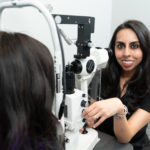
Dr. Kazmi in the exam room with a patient. Dr. Kazmi says dry eye services fulfill and important and ever-growing patient need while delivering significant practice profitability.
By Aamena M. Kazmi, Therapeutic Optometrist,
Diplomate, ABO
March 23, 2022
Dry eye is an under-diagnosed disease. Most people with dry eye have no idea why they are experiencing discomfort. In our practice, great attention has been devoted to diagnosing and treating this condition. Here is how we created a dry eye sub-specialty that is beneficial to patients while generating significant profitability.
In 2021, we diagnosed more than 1,500 patients with dry eye syndrome/meibomian gland dysfunction. We initiated at least first-tier treatment (i.e. drop recommendations, warm compresses, lid hygiene) on 100 percent of these patients. In 2021, the diagnosis and management of dry eye syndrome yielded over $100,000 in annual revenue. This was likely greater in 2019, prior to the pandemic.
*The more than $100,000 cited is in addition to the normal exam fees. For example, in some patients only an early diagnosis was made and yielded the sale of a drop or compress only.
The Instrumentation that Helps Us Diagnose & Treat Dry Eye Patients
The key instruments for diagnosis that we use are the Oculus Keratograph 5M ($29,200 – paid in full with cash) and the Johnson & Johnson LipiScan ($11,854). We also use standard exam room tests, including Schirmer’s test, NaFl strips and Lissamine Green strips, and hope to add TearLab Osmolarity testing when feasible.
We run the LipiScan on all routine patients over 17 years of age. We use the LipiScan as a baseline screener to determine the anatomical status of the patient’s meibomian glands. If the images depict truncated or atrophied glands, we refer patients to return for a comprehensive dry eye exam with me. Having images to share with the patient of what we are seeing has resonated well and increased compliance dramatically.
Our key instruments for treatment include the Johnson & Johnson LipiFlow ($35,722) and BlephEx ($5,000, paid in full with cash). We pay $1,063 monthly on the J&J system. We purchased the LipiScan/LipiFlow system in December 2018 for $47,749 and earned $53,530 in revenue in 2019. Each procedure costs $200 to perform (cost of the activators). Each BlephEx procedure costs $34.75 to perform (cost of the probes). We also use punctal plugs for treatment ($60 cost). Annual gross revenue generated from LipiFlow and BlephEx procedures in the last three years are as follows:
LipiFlow: $30,000 (2021); $21,000 (2020); $53,530 (2019)
BlephEx: $4,400 (2021); $3,600 (2020); $6,000 (2019)
I believe the drop in revenues was due to the pandemic, and will hopefully rise again this year.
Create a Dry Eye One-Stop-Shop for Patients
You probably will prescribe products for patients to use at home to treat their dry eye. Rather than sending them on a scavenger hunt for those products, you can profitably sell them in your office.
All of the products we prescribe for dry eye are available to purchase in-office. These products include:
Optase Dry Eye Intense Drops
Optase Eyelid Cleansing Wipes with Tea Tree Oil
The Eye Doctor Plus Eye Compress (previously we used the Bruder Mask)
HydroEye Dry Eye Formula Soft Gels
Total revenue generated annually from sale of these products – $8,000-$10,000
We also plan to incorporate eye makeup products such as the We Love Eyes and OCuSoft Zoria lines in the near future.
Create a System for Identifying Dry Eye Patients on Your Schedule
We have a color-coded system in our scheduler, and dry eye exams have a designated color with extra time allotted in the schedule. The separate color distinction alerts our technicians of the purpose of the exam and prompts them that additional pretesting is needed. The extra time allows for all the preliminary exam data to be collected and gives the practitioner additional time to obtain a detailed history, educate patients on exam findings and counsel them on prescribed treatment methods.
Other Articles to Explore
Ten years ago, our practice started a specialty contact lens division, which we recently rebranded to have its own name. We foresee the dry eye specialty following a similar track in the future, eventually rebranding it as a separate entity within the practice.
Train Staff to Support Doctors in Serving Dry Eye Patients
I find it helpful to train support staff on keywords patients might use when they are gathering the patients’ chief complaint. We also use the SPEED dry-eye questionnaire. Our staff is trained on scoring the questionnaire and asking appropriate follow-up questions as needed.
Let Your Community Know You Diagnose & Treat Dry Eye
We have always been proactive in managing ocular diseases in-house until surgery or ophthalmologic intervention is truly warranted. We always aim to diagnose and treat dry eye as early as possible to prevent worsening symptoms over time. Consequently, it came as no surprise to our patients when we began acquiring additional technology to build a dry eye sub-specialty. Our patients are extremely loyal to our practice and have confidence that we will manage their cases in the best way possible. Because of this, they welcomed the idea of treating their dry eye at our optometry practice rather than being referred out to ophthalmology.
We use exam time (educate patients during their routine exam), infographics and vlogs on our social media platforms, blog posts on our practice website, and photo images highlighting our latest technology, to inform our patients and community of our updated services. We also added “dry eye treatment” on the practice service menu that we have listed behind our front desk, as well as on our practice website.
With the right diagnostic and treatment investments, and thorough patient education and marketing, you can build a dry eye practice that is almost immediately profitable.
 Aamena M. Kazmi, Therapeutic Optometrist, Diplomate, ABO, practices at Bellaire Family Eye Care (BFE) in Houston, Texas. To contact her: Kazmi@bfeye.com
Aamena M. Kazmi, Therapeutic Optometrist, Diplomate, ABO, practices at Bellaire Family Eye Care (BFE) in Houston, Texas. To contact her: Kazmi@bfeye.com





















